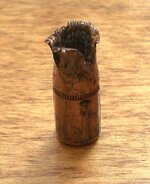- Messages
- 202
- Reactions
- 76
My H&R .357 magnum rifle has a very long throat and that gives me the opportunity to seat bullets very shallow allowing for more powder. In effect, I can get Remington Maximum velocities in a SAAMI magnum chamber and magnum cases. I've detailed these loads on my website at H&R Handi.
The 140 gr. FTX load is not quite there, but is close to a Maxi load. The 200 gr. FTX is there at just under 17 gr. of IMR4227. I've determined that 18 gr. of IMR4227 is maximum in this rifle and that is the listed maximum on Hodgdon's data as well for a 200 gr. bullet in a .357 Rem. Maxi.
I had a chance Saturday to fire those new loads at long ranges. I fired 45 rounds of the 140 gr. FTX loads and 50 rounds of the 200 gr. FTX loads. All of them performed very well. I was particularly happy with the 200 gr. FTX loads. I was shooting standing, off hand, and able to get consistant hits on small rocks and sticks at around 125 yards. Also had several hits on a 8" diameter steel plate well over 200 yards out hung on a chain. The 200 gr. bullets made the plate dance wildly.
I don't have a range nearby to bench rest test these for accuracy. I'm searching for a nice level place in the woods where I can set up a table and measure out 100 yards, but that's hard to find in the mountains and canyons of our nearby Coast Range. But judging from the consistant hits on small rocks and sticks at 125 yards, it seems a good bet to be more than adequate for deer out to 200 yards.
Now I just need to fine tune the scope and red dot to suit the trajectory.
The 140 gr. FTX load is not quite there, but is close to a Maxi load. The 200 gr. FTX is there at just under 17 gr. of IMR4227. I've determined that 18 gr. of IMR4227 is maximum in this rifle and that is the listed maximum on Hodgdon's data as well for a 200 gr. bullet in a .357 Rem. Maxi.
I had a chance Saturday to fire those new loads at long ranges. I fired 45 rounds of the 140 gr. FTX loads and 50 rounds of the 200 gr. FTX loads. All of them performed very well. I was particularly happy with the 200 gr. FTX loads. I was shooting standing, off hand, and able to get consistant hits on small rocks and sticks at around 125 yards. Also had several hits on a 8" diameter steel plate well over 200 yards out hung on a chain. The 200 gr. bullets made the plate dance wildly.
I don't have a range nearby to bench rest test these for accuracy. I'm searching for a nice level place in the woods where I can set up a table and measure out 100 yards, but that's hard to find in the mountains and canyons of our nearby Coast Range. But judging from the consistant hits on small rocks and sticks at 125 yards, it seems a good bet to be more than adequate for deer out to 200 yards.
Now I just need to fine tune the scope and red dot to suit the trajectory.












